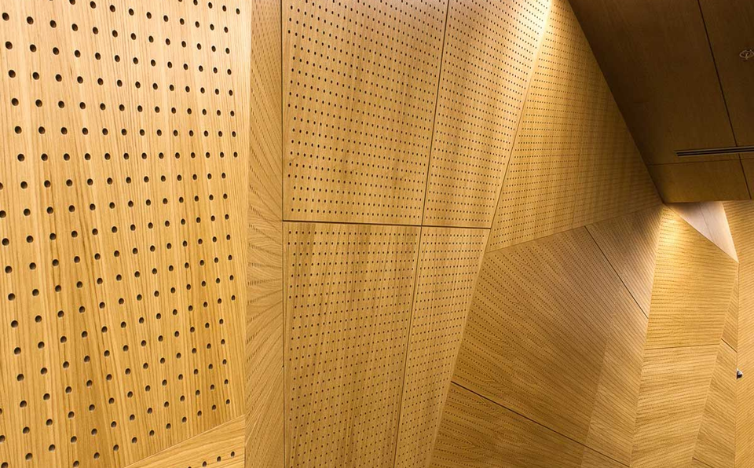Perforated acoustic panels are engineered sound-absorbing materials designed to enhance room acoustics by reducing noise, echo, and reverberation. These panels feature precisely drilled holes or perforations that allow sound waves to penetrate the panel’s core, where they are absorbed and dissipated. Used in offices, auditoriums, studios, and residential spaces, these panels combine functionality with aesthetic appeal, making them a popular choice for modern architectural design.
How Perforated Acoustic Panels Work
The science behind perforated acoustic panels lies in their design. The perforations (small holes) allow sound waves to pass through the surface and enter an absorbent backing material, such as fiberglass, foam, or mineral wool. Once inside, the sound energy converts into minimal heat, effectively reducing reflections.
Key Factors Affecting Performance:
- Hole Size & Spacing – Smaller, closely spaced holes absorb higher frequencies, while larger holes handle lower frequencies.
- Material Density – Denser materials improve low-frequency absorption.
- Panel Thickness – Thicker panels enhance overall sound absorption.
Benefits of Using Perforated Acoustic Panels
 1. Superior Noise Reduction
1. Superior Noise Reduction
These panels significantly reduce unwanted noise and echo, creating a more comfortable environment for work, entertainment, or relaxation.
2. Enhanced Aesthetic Appeal
Available in wood, metal, gypsum, and fabric finishes, perforated panels can blend seamlessly into modern interiors while improving acoustics.
3. Improved Speech Clarity & Sound Quality
Ideal for conference rooms, theaters, and classrooms, these panels minimize sound distortion, ensuring clear communication.
4. Customizable Designs
Manufacturers offer various hole patterns, colors, and shapes, allowing for creative and functional installations.
5. Durability & Low Maintenance
Made from high-quality materials, these panels are long-lasting and easy to clean, making them a cost-effective solution.
Common Applications of Perforated Acoustic Panels
- Offices & Workspaces – Reduces distractions in open-plan offices.
- Recording Studios & Theaters – Enhances sound clarity and minimizes echoes.
- Restaurants & Cafes – Creates a pleasant dining atmosphere by lowering noise levels.
- Educational Institutions – Improves lecture hall and classroom acoustics.
- Home Theaters & Living Spaces – Provides a premium audio experience.
Types of Perforated Acoustic Panels
- Wooden Perforated Panels – Natural and elegant, ideal for stylish interiors.
- Metal Perforated Panels – Durable and modern, often used in industrial settings.
- Fabric-Wrapped Panels – Softens sound while offering design flexibility.
- Gypsum Perforated Panels – Fire-resistant and suitable for ceilings and walls.
Installation Tips for Best Performance
- Wall & Ceiling Mounting – Proper placement maximizes sound absorption.
- Spacing & Coverage – Even distribution ensures uniform acoustics.
- Combining with Other Acoustic Treatments – Works well with bass traps and diffusers for full-range sound control.
Contact Muhammad Shaheen Carpentry at 971 55 219 6236, and discover the transformative science of soundproofing for your space.
Conclusion
Perforated acoustic panels are a versatile and effective solution for managing sound in any space. Whether for professional studios, corporate offices, or home interiors, these panels provide noise reduction, aesthetic value, and improved acoustics. Investing in high-quality perforated panels ensures a better auditory experience and a more comfortable environment.

